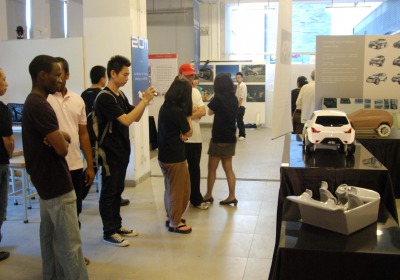Central Academy of Fine Arts degree show 2009, China
Tue, 09 Jun 2009China's home grown car makers are increasingly ambitious, as illustrated by plans to grow rapidly at home and, in some cases, expand abroad and compete with foreign rivals in cutting-edge technologies. One big impediment they face in taking on their foreign rivals is design.
Top dogs in the global auto industry invest heavily in engineers and designers. They spend years and millions of dollars designing new cars. But many Chinese automakers, especially smaller independent ones, actually do very little of that and are more often than not accused of stealing design; not that designers at well-established global carmakers don't steal ideas from each other, but Chinese companies have elevated that art to new heights.
A senior executive of a small not-so-successful automaker in China's northern province recently laid it out over a cup of tea: the reason his company can sell cars much cheaper than foreign automakers that also produce cars in China, he said, is that his company does not engineer or design cars at all. Instead, the company hires an outside engineering consultant, tells its engineers which existing model they want to copy and asks them to come up with a product counterfeited in a way that won't attract intellectual property lawsuits. In some cases, that means companies combine styling ideas from two separate cars into one. (Example: Think Great Wall Motor Co.'s Florid, which combines the front end of the Toyota Yaris and the back end of the Scion xA.)
Things are changing, albeit slowly however - a fact that became clear at this year's year-end review of second- and third-year transportation design students at Beijing's prestigious Central Academy of Fine Arts (CAFA). What was also clear, as Edward Wong, director of the school's transportation design department, reviewed the students' work on a recent Saturday, was that China's auto design conundrum isn't due to a lack of talent.
Take, for instance, Phoenix Wang, "class leader" of CAFA's second-year transportation design students, whose designs have put her near the top of her class. The project that Ms Wang (a 22-year-old from Sichuan) and a half dozen other fellow third-year students pursued this school year was to create the battery-powered electric taxi of the future.
She was the first one to go through Wong's review process, and the director pounced on the flaws of her design: "Your plan view is too thin - not enough meat on the fender." Fellow student Andy Lang also got chewed out - not for his design but his execution. Wong was upset about the lack of attention to detail evident in his design, especially the way he packaged the car: not enough head room in the second seat - perhaps a fatal flaw for a cab?
"Where do the powertrain and the battery pack go in this car? You need to show clearly where those critical components are going to go, and how they are going to be packaged in the car," Wong pointed out. Lang also was told to brush up on his drawing skills: in one sketch he showed in his presentation, the car's fender was almost as tall as a person standing next to it. "That would make this one hell of a big car!"
Those tough words, however, belie the high expectations Wong has for his students. Later on, in his office, he gave nothing but praise for their efforts - for instance, for Wang's still-a-bit-amateurish but unique design. "The car is almost symmetrical, isn't it," Wong says, amused.Continues →
By Jeffrey Nagaoka

